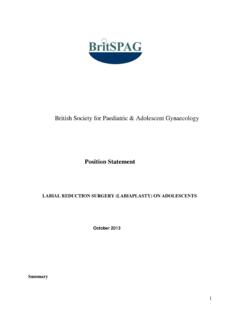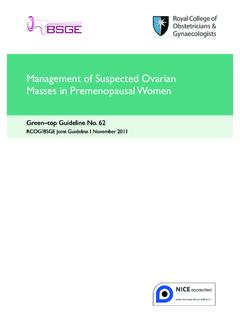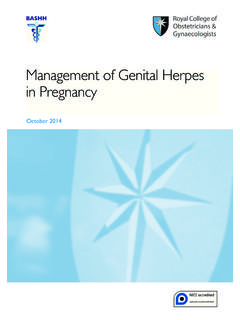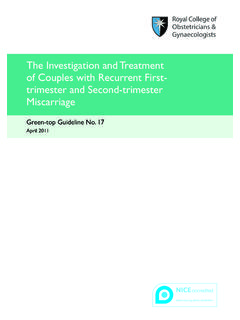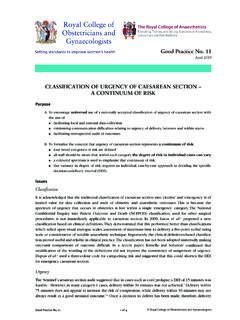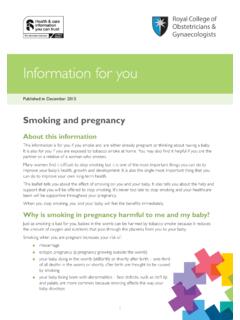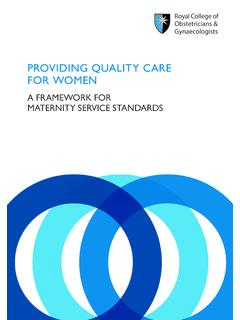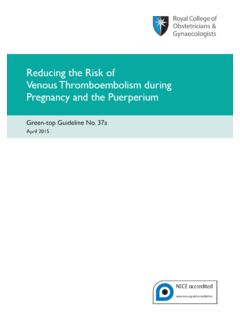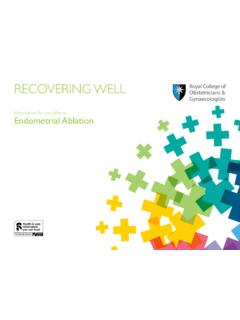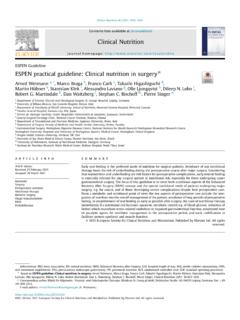Transcription of Management of Women with Obesity in Pregnancy
1 CMACE/RCOG Joint Guideline Management of Women with Obesity in Pregnancy March 2010 Centre for Maternal and Child Enquiries Improving the health of mothers, babies and children This guideline was produced on behalf of the Centre for Maternal and Child Enquiries and the Royal College of Obstetricians and Gynaecologists by: J Modder MRCOG, CMACE and KJ Fitzsimons , CMACE and reviewed by the RCOG guidelines Committee. The final version is the responsibility of both CMACE and the guidelines Committee of the RCOG. Updates of this guideline will be the responsibility of the guidelines Committee of the RCOG. DISCLAIMERS CMACE ACKNOWLEDGEMENTS AND DISCLAIMER This work was undertaken by the Centre for Maternal and Child Enquiries (CMACE) as part of the CEMACH programme.
2 The work was funded by the National Patient Safety Agency; the Department of Health, Social Services and Public Safety of Northern Ireland; NHS Quality Improvement Scotland (NHS QIS); and the Channel Islands and Isle of Man. The views expressed in this guideline do not necessarily represent the views of the funding bodies. The recommendations contained in this guideline represent the view of CMACE, the CMACE Obesity Consensus Standards Group and the RCOG Guideline Committee. They do not override healthcare professionals individual responsibility to make appropriate decisions in the circumstances of the individual patient, in consultation with the patient and/or guardian or carer. RCOG DISCLAIMER The Royal College of Obstetricians and Gynaecologists produces guidelines as an educational aid to good clinical practice.
3 They present recognised methods and techniques of clinical practice, based on published evidence, for consideration by obstetricians and gynaecologists and other relevant health professionals. The ultimate judgement regarding a particular clinical procedure or treatment plan must be made by the doctor or other attendant in the light of clinical data presented by the patient and the diagnostic and treatment options available within the health services available. This means that RCOG guidelines are unlike protocols or guidelines issued by employers, as they are not intended to be prescriptive directions defining a single course of Management . Departure from the local prescriptive protocols or guidelines should be fully documented in the patient s case notes at the time the relevant decision is taken.
4 Once adapted for local use, these guidelines are no longer representative of the RCOG. The guidelines review process will commence in 2013 unless otherwise indicated Jointly published by the Centre for Maternal and Child Enquiries and the Royal College of Obstetricians and Gynaecologists. CMACE is a Company Limited by Guarantee. Registered in England and Wales No. 6610301. CMACE Registered Charity No. 1128873 RCOG Registered Charity No. 213280 Copyright Centre for Maternal and Child Enquiries and Royal College of Obstetricians and Gynaecologist Permission is granted to reproduce for personal and educational use only. Page 1 of 29 March 2010 CMACE/RCOG JOINT GUIDELINE Management OF Women WITH Obesity IN Pregnancy 1. Purpose and scope .. 2 2. Background and introduction.
5 2 3. Methodology .. 2 4. Pre- Pregnancy care .. 4 5. Provision of antenatal care .. 5 6. Measuring weight, height and 6 7. Information-giving during Pregnancy .. 6 8. Risk assessment during Pregnancy .. 7 9. Thromboprophylaxis .. 7 10. Maternal surveillance and screening .. 9 11. Planning labour and 10 12. Care during childbirth .. 11 13. Postnatal care and follow-up after Pregnancy .. 13 14. Local guidelines .. 15 15. Facilities and 15 16. Education of health 16 17. Areas for further research .. 17 18. Auditable standards .. 17 18 APPENDIX 1: Process for developing the consensus standards .. 22 APPENDIX 2: Levels and grades of evidence .. 26 APPENDIX 3: Maternal and fetal risks in Women with a BMI 30 kg/m2 compared to Women with a healthy BMI .. 27 APPENDIX 4: Pre- Pregnancy , antenatal and postnatal care pathway for Women with Obesity .
6 29 Centre for Maternal and Child Enquiries Improving the health of mothers, babies and children CMACE/RCOG Joint Guideline: Management of Women with Obesity in Pregnancy Page 2 of 29 March 2010 1. Purpose and scope Maternal Obesity has become one of the most commonly occurring risk factors in obstetric practice. Obesity in Pregnancy is usually defined as a Body Mass Index (BMI) of 30 kg/m2 or more at the first antenatal consultation. BMI is a simple index of weight-for-height and is calculated by dividing a person s weight in kilograms by the square of their height in metres (kg/m2). There are three different classes of Obesity : BMI (Class I); BMI (Class 2); and BMI 40 and over (Class 3 or morbid Obesity ),1,2 which recognise the continuous relationship between BMI and morbidity and While the majority of the recommendations within this guideline pertain to Women with a BMI 30, some recommendations are specific to Women in the higher classes of Obesity only.
7 Obese Women with a BMI below the threshold specified may also benefit from the particular recommendation; however, the chosen BMI cut-offs reflect careful consideration given to the balance of medical intervention versus risk, differences in local prevalence of maternal Obesity , and resource implications for local healthcare organisations. Local maternity services may wish to implement these standards for all Women with maternal Obesity after consideration of these issues. The recommendations cover interventions prior to conception, during and after Pregnancy . This guideline does not address the following areas: Management of Pregnancy following bariatric surgery; anti- Obesity drugs in Pregnancy ; technique and frequency of ultrasound scanning; gestational weight gain; dietary and exercise advice; and postnatal contraception.
8 The National Institute for Health and Clinical Excellence (NICE) is currently developing a guideline on Weight Management in Pregnancy and after Childbirth. The guideline is due to be published in July 2010 and will cover dietary and physical activity interventions and monitoring weight. 2. Background and introduction The prevalence of Obesity in the general population in England has increased markedly since the early The prevalence of Obesity in Pregnancy has also been seen to increase, rising from 9 10% in the early 1990s to 16 19% in the ,5 Obesity in Pregnancy is associated with an increased risk of a number of serious adverse outcomes, including miscarriage,6 fetal congenital anomaly,7 thromboembolism,8,9 gestational diabetes,10 pre-eclampsia,11 dysfunctional labour,12 postpartum haemorrhage,10 wound infections,10 stillbirth13.
9 14 and neonatal There is a higher caesarean section rate17 and lower breastfeeding rate18 in this group of Women compared to Women with a healthy BMI. There is also evidence to suggest that Obesity may be a risk factor for maternal death: the Confidential Enquiry into Maternal and Child Health s report on maternal deaths in the 2003 2005 triennium showed that 28% of mothers who died were obese,19 whereas the prevalence of Obesity in the general maternity population within the same time period was 16-19%. 4,5 3. Methodology This CMACE/RCOG guideline is based on standards of care developed as part of a national enquiry project on Obesity in Pregnancy conducted by the Centre for Maternal and Child Enquiries (CMACE) and funded by the National Patient Safety Agency and by contributions from all the UK nations.
10 The development of standards included searching for and preparing scientific evidence, consulting with stakeholders, establishing an expert multidisciplinary group, and developing standards through a formal consensus process. Further details of the consensus and review processes can be found in Appendix 1. Medline, EMBASE and the Cochrane Database of Systematic Reviews were searched using terms relating to Obesity , Pregnancy , services and interventions. Searches were limited to humans and restricted to the titles of English language articles published between January 1998 and January 2008. Meta-analyses, systematic reviews, intervention studies and observational studies were selected if they: 1) related to general care issues for pregnant CMACE/RCOG Joint Guideline: Management of Women with Obesity in Pregnancy Page 3 of 29 March 2010 obese Women , 2) focused on the Management of Obesity or Obesity -related complications in Pregnancy , or 3) focused on the relationship between maternal Body Mass Index (BMI) and Pregnancy -related outcomes.
